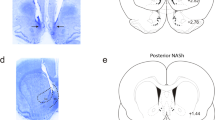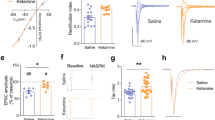Abstract
The rewarding effect of drugs of abuse is mediated by activation of the mesolimbic dopamine system, which is inhibited by putative anti-craving compounds. Interestingly, different GABAB receptor agonists can exert similarly opposing effects on the reward pathway, but the cellular mechanisms involved are unknown. Here we found that the coupling efficacy (EC50) of G-protein-gated inwardly rectifying potassium (GIRK, Kir3) channels to GABAB receptor was much lower in dopamine neurons than in GABA neurons of the ventral tegmental area (VTA), depending on the differential expression of GIRK subunits. Consequently, in rodent VTA slices, a low concentration of the canonical agonist baclofen caused increased activity, whereas higher doses eventually inhibited dopamine neurons. At behaviorally relevant dosages, baclofen activated GIRK channels in both cell types, but the drug of abuse γ-hydroxy-butyric acid (GHB) activated GIRK channels only in GABAergic neurons. Thus GABAB receptor agonists exert parallel cellular and behavioral effects due to the cell-specific expression of GIRK subunits.
This is a preview of subscription content, access via your institution
Access options
Subscribe to this journal
Receive 12 print issues and online access
$209.00 per year
only $17.42 per issue
Buy this article
- Purchase on Springer Link
- Instant access to full article PDF
Prices may be subject to local taxes which are calculated during checkout







Similar content being viewed by others
References
Robbins, T.W. & Everitt, B.J. Drug addiction: bad habits add up. Nature 398, 567–570 (1999).
Brebner, K., Childress, A.R. & Roberts, D.C. A potential role for GABAB agonists in the treatment of psychostimulant addiction. Alcohol Alcohol 37, 478–484 (2002).
Cousins, M.S., Roberts, D.C. & de Wit, H. GABAB receptor agonists for the treatment of drug addiction: a review of recent findings. Drug Alcohol Depend. 65, 209–220 (2002).
Martellotta, M.C., Cossu, G., Fattore, L., Gessa, G.L. & Fratta, W. Intravenous self-administration of gamma-hydroxybutyric acid in drug-naive mice. Eur. Neuropsychopharmacol. 8, 293–296 (1998).
Nicholson, K.L. & Balster, R.L. GHB: a new and novel drug of abuse. Drug Alcohol Depend. 63, 1–22 (2001).
Johnson, S.W. & North, R.A. Opioids excite dopamine neurons by hyperpolarization of local interneurons. J. Neurosci. 12, 483–488 (1992).
McFarland, K. & Kalivas, P.W. The circuitry mediating cocaine-induced reinstatement of drug-seeking behavior. J. Neurosci. 21, 8655–8663 (2001).
Lüscher, C., Jan, L.Y., Stoffel, M., Malenka, R.C. & Nicoll, R.A. G protein-coupled inwardly rectifying K+ channels (GIRKs) mediate postsynaptic but not presynaptic transmitter actions in hippocampal neurons. Neuron 19, 687–695 (1997).
Patel, A.J. & Honore, E. Properties and modulation of mammalian 2P domain K+ channels. Trends Neurosci. 24, 339–346 (2001).
Krapivinsky, G. et al. The G-protein-gated atrial K+ channel IKACh is a heteromultimer of two inwardly rectifying K+-channel proteins. Nature 374, 135–141 (1995).
Lesage, F. et al. Cloning provides evidence for a family of inward rectifier and G-protein coupled K+ channels in the brain. FEBS Lett. 353, 37–42 (1994).
Dascal, N. et al. Atrial G protein-activated K+ channel: expression cloning and molecular properties. Proc. Natl. Acad. Sci. USA 90, 10235–10239 (1993).
Kubo, Y., Reuveny, E., Slesinger, P.A., Jan, Y.N. & Jan, L.Y. Primary structure and functional expression of a rat G-protein-coupled muscarinic potassium channel. Nature 364, 802–806 (1993).
Wickman, K., Pu, W.T. & Clapham, D.E. Structural characterization of the mouse Girk genes. Gene 284, 241–250 (2002).
Liao, Y.J., Jan, Y.N. & Jan, L.Y. Heteromultimerization of G-protein-gated inwardly rectifying K+ channel proteins GIRK1 and GIRK2 and their altered expression in weaver brain. J. Neurosci. 16, 7137–7150 (1996).
Jelacic, T.M., Sims, S.M. & Clapham, D.E. Functional expression and characterization of G-protein-gated inwardly rectifying K+ channels containing GIRK3. J. Membr. Biol. 169, 123–129 (1999).
Schoots, O. et al. Co-expression of human Kir3 subunits can yield channels with different functional properties. Cell Signal 11, 871–883 (1999).
Slesinger, P.A. et al. Functional effects of the mouse weaver mutation on G protein-gated inwardly rectifying K+ channels. Neuron 16, 321–331 (1996).
Inanobe, A. et al. Characterization of G-protein-gated K+ channels composed of Kir3.2 subunits in dopaminergic neurons of the substantia nigra. J. Neurosci. 19, 1006–1017 (1999).
Jelacic, T.M., Kennedy, M.E., Wickman, K. & Clapham, D.E. Functional and biochemical evidence for G-protein-gated inwardly rectifying K+ (GIRK) channels composed of GIRK2 and GIRK3. J. Biol. Chem. 275, 36211–36216 (2000).
Lesage, F. et al. Molecular properties of neuronal G-protein-activated inwardly rectifying K+ channels. J. Biol. Chem. 270, 28660–28667 (1995).
Wei, J. et al. Characterization of murine Girk2 transcript isoforms: structure and differential expression. Genomics 51, 379–390 (1998).
Lingenhoehl, K. et al. Gamma-hydroxybutyrate is a weak agonist at recombinant GABAB receptors. Neuropharmacol. 38, 1667–1673 (1999).
Madden, T.E. & Johnson, S.W. Gamma-hydroxybutyrate is a GABAB receptor agonist that increases a potassium conductance in rat ventral tegmental dopamine neurons. J. Pharm. Exp. Ther. 287, 261–265 (1998).
Carter, L.P. et al. The role of GABAB receptors in the discriminative stimulus effects of gamma-hydroxybutyrate in rats: time course and antagonism studies. J. Pharm. Exp. Ther. 305, 668–674 (2003).
White, J.H. et al. Heterodimerization is required for the formation of a functional GABAB receptor. Nature 396, 679–682 (1998).
Kaupmann, K. et al. GABAB-receptor subtypes assemble into functional heteromeric complexes. Nature 396, 683–687 (1998).
Schuler, V. et al. Epilepsy, hyperalgesia, impaired memory, and loss of pre- and postsynaptic GABAB responses in mice lacking GABAB1. Neuron 31, 47–58 (2001).
Billinton, A., Upton, N. & Bowery, N.G. GABAB receptor isoforms GBR1a and GBR1b, appear to be associated with pre- and post-synaptic elements respectively in rat and human cerebellum. Br. J. Pharmacol. 126, 1387–1392 (1999).
Brauner-Osborne, H. & Krogsgaard-Larsen, P. Functional pharmacology of cloned heterodimeric GABAB receptors expressed in mammalian cells. Br. J. Pharmacol. 128, 1370–1374 (1999).
Pfaff, T. et al. Alternative splicing generates a novel isoform of the rat metabotropic GABABR1 receptor. Eur. J. Neurosci. 11, 2874–2882 (1999).
Karschin, C., Dissmann, E., Stuhmer, W. & Karschin, A. IRK(1–3) and GIRK(1–4) inwardly rectifying K+ channel mRNAs are differentially expressed in the adult rat brain. J. Neurosci. 16, 3559–3570 (1996).
Wickman, K., Karschin, C., Karschin, A., Picciotto, M.R. & Clapham, D.E. Brain localization and behavioral impact of the G-protein-gated K+ channel subunit GIRK4. J. Neurosci. 20, 5608–5615 (2000).
Torrecilla, M. et al. G-protein-gated potassium channels containing Kir3.2 and Kir3.3 subunits mediate the acute inhibitory effects of opioids on locus ceruleus neurons. J. Neurosci. 22, 4328–4334 (2002).
Ma, D. et al. Diverse trafficking patterns due to multiple traffic motifs in G protein-activated inwardly rectifying potassium channels from brain and heart. Neuron 33, 715–729 (2002).
Jeong, S.W. & Ikeda, S.R. Endogenous regulator of G-protein signaling proteins modify N-type calcium channel modulation in rat sympathetic neurons. J. Neurosci. 20, 4489–4496 (2000).
Huang, C.L., Feng, S. & Hilgemann, D.W. Direct activation of inward rectifier potassium channels by PIP2 and its stabilization by Gbetagamma. Nature 391, 803–806 (1998).
Logothetis, D.E., Kurachi, Y., Galper, J., Neer, E.J. & Clapham, D.E. The beta gamma subunits of GTP-binding proteins activate the muscarinic K+ channel in heart. Nature 325, 321–326 (1987).
Reuveny, E. et al. Activation of the cloned muscarinic potassium channel by G protein beta gamma subunits. Nature 370, 143–146 (1994).
Johnson, S.W. & North, R.A. Two types of neurone in the rat ventral tegmental area and their synaptic inputs. J. Physiol. (Lond.) 450, 455–468 (1992).
Sugita, S., Johnson, S.W. & North, R.A. Synaptic inputs to GABAA and GABAB receptors originate from discrete afferent neurons. Neurosci. Lett. 134, 207–211 (1992).
Matindale – The Complete Drug Reference p. 2496 (The Pharmaceutical Press, 2002).
Kalivas, P.W. Neurotransmitter regulation of dopamine neurons in the ventral tegmental area. Brain Res. Brain Res. Rev. 18, 75–113 (1993).
Kalivas, P.W., Duffy, P. & Eberhardt, H. Modulation of A10 dopamine neurons by gamma-aminobutyric acid agonists. J. Pharm. Exp. Ther. 253, 858–866 (1990).
Feigenbaum, J.J. & Howard, S.G. Does gamma-hydroxybutyrate inhibit or stimulate central DA release? Int. J. Neurosci. 88, 53–69 (1996).
Gallimberti, L. et al. Gamma-hydroxybutyric acid for treatment of alcohol withdrawal syndrome. Lancet 2, 787–789 (1989).
Snead, O.C. III. Evidence for a G protein-coupled gamma-hydroxybutyric acid receptor. J. Neurochem. 75, 1986–1996 (2000).
Andriamampandry, C. et al. Cloning and characterization of a rat brain receptor that binds the endogenous neuromodulator gamma-hydroxybutyrate (GHB). FASEB J. 17, 1691–1693 (2003).
Quéva, C. et al. Effects of GABA agonists on body temperature regulation in GABAB(1)−/− mice. Brit. J. Pharmacol. 140, 315–322 (2003).
Kaupmann, K. et al. Specific γ-hydroxybutyrate (GHB) binding sites but loss of pharmacological effects of GHB in GABAB(1) deficient mice. Eur. J. Neurosci. 18, 2722–2730 (2003).
Acknowledgements
We thank the members of the Lüscher lab for many helpful discussions, L. Jan for the GABABR1 and GABABR2 cDNA, D. Clapham for GIRK3 cDNA, M. Lazdunski for GIRK2a cDNA, and A. Gittis for some of the dose-response data. We also thank C. Fiorillo, M. Frerking, and M. Mühlethaler for comments on an earlier version of the manuscript, and F. Loctin for technical assistance. M.L is supported, in part, by the Danish Natural Science Research Council. C.L. is supported by grants of the Swiss National Science Foundation. C.L. and P.A.S. share a Human Science Frontier Project Young Investigator's grant.
Author information
Authors and Affiliations
Corresponding authors
Ethics declarations
Competing interests
The authors declare no competing financial interests.
Supplementary information
Supplementary Fig. 1
GIRK current desensitization in DA neurons of the VTA is a function of agonist concentration. (a) Representative traces at baclofen concentrations as indicated. Scale bar 2.5 min/200 pA. (b) Average desensitization after 15 min of continuous baclofen application at increasing concentration (n > 5 for each point). Note that below 1 μM, no desensitization was observed. (GIF 5 kb)
Supplementary Fig. 2
Differential coupling efficacy (EC50) of GIRK channels in VTA neurons is sufficient to explain bi-directional effects of GABAB receptor agonists on the mesolimbic dopamine system. The VTA contains dopamine neurons that are under inhibitory control by local GABA neurons. Both cell types receive excitatory (mainly from the prefrontal cortex and the pedunculo pontine tegmental nucleus; not drawn) and inhibitory inputs (from the pallidum (GP) and nucleus accumbens, NAc)41. In the acute slice preparation all these distant afferents are cut, leaving local GABA neurons to exert an inhibitory control of dopamine neurons. Since dopamine neurons are less sensitive to GABABR agonists than GABA neurons (note significantly higher EC50 for baclofen compared to the EC50 of pre- as well as postsynaptic inhibition in GABA neurons) low agonist concentrations will lead to disinhibition while at higher concentrations both cell types will stop firing. (JPG 71 kb)
Rights and permissions
About this article
Cite this article
Cruz, H., Ivanova, T., Lunn, ML. et al. Bi-directional effects of GABAB receptor agonists on the mesolimbic dopamine system. Nat Neurosci 7, 153–159 (2004). https://doi.org/10.1038/nn1181
Received:
Accepted:
Published:
Issue Date:
DOI: https://doi.org/10.1038/nn1181
This article is cited by
-
Activation of RMTg projections to the VTA reverse cocaine-induced molecular adaptation in the reward system
Translational Psychiatry (2024)
-
Ethanol blocks a novel form of iLTD, but not iLTP of inhibitory inputs to VTA GABA neurons
Neuropsychopharmacology (2023)
-
TAAR1 agonist ulotaront modulates striatal and hippocampal glutamate function in a state-dependent manner
Neuropsychopharmacology (2023)
-
Nanoscale alterations in GABAB receptors and GIRK channel organization on the hippocampus of APP/PS1 mice
Alzheimer's Research & Therapy (2022)
-
Combining NGN2 programming and dopaminergic patterning for a rapid and efficient generation of hiPSC-derived midbrain neurons
Scientific Reports (2022)



